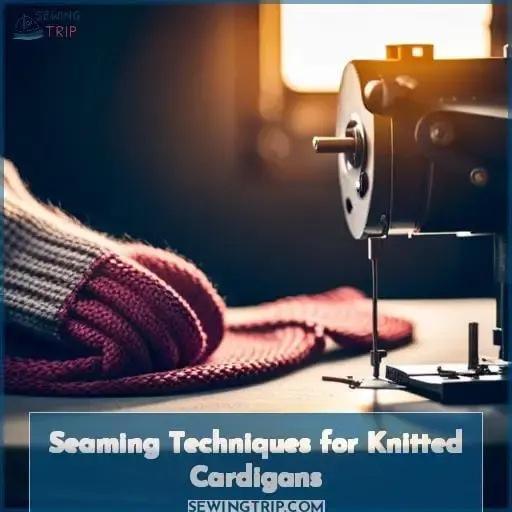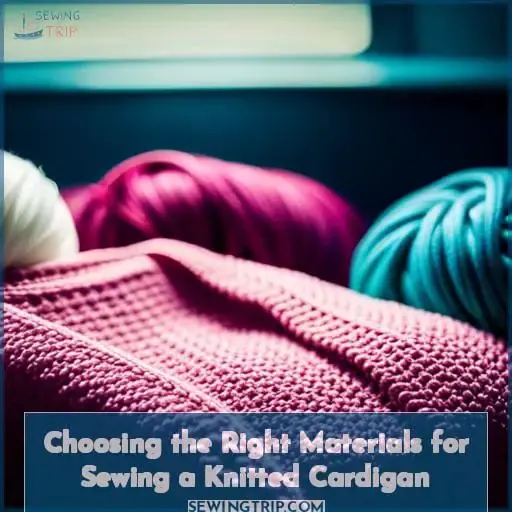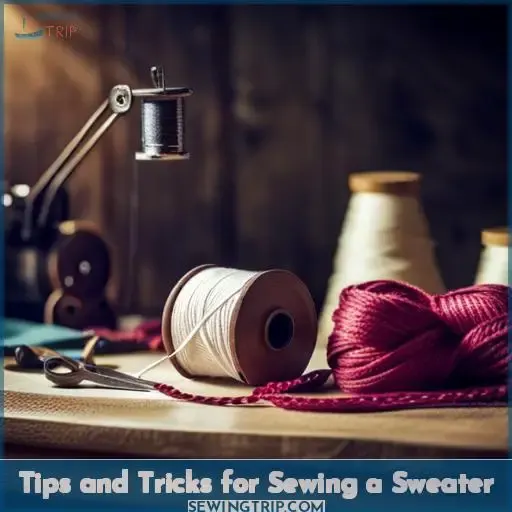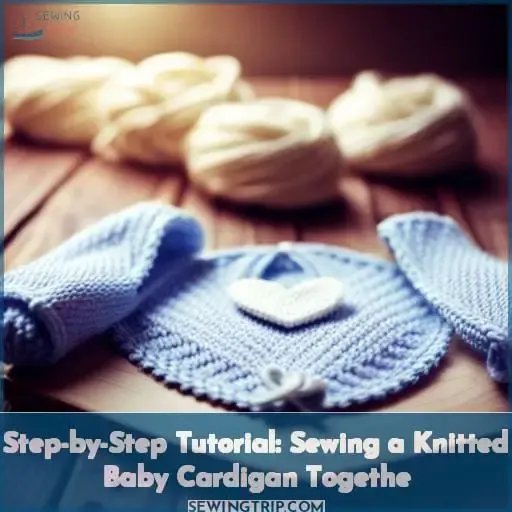This site is supported by our readers. We may earn a commission, at no cost to you, if you purchase through links.
 Imagine finally finishing that beautiful knitted cardigan you’ve been working on for weeks. Now comes the crucial step of sewing it up to perfection. Don’t worry, we’re here to guide you through the process with our step-by-step tutorial on how to seam knitted cardigans.
Imagine finally finishing that beautiful knitted cardigan you’ve been working on for weeks. Now comes the crucial step of sewing it up to perfection. Don’t worry, we’re here to guide you through the process with our step-by-step tutorial on how to seam knitted cardigans.
From mastering the mattress stitch technique to choosing the right materials and adding those professional finishing touches, this guide will empower you with all the tips and tricks needed for a flawless result.
Table Of Contents
- Key Takeaways
- Seaming Techniques for Knitted Cardigans
- Choosing the Right Materials for Sewing a Knitted Cardigan
- Tips and Tricks for Sewing a Sweater
- Finishing Touches for a Professional-Looking Cardigan
- Step-by-Step Tutorial: Sewing a Knitted Baby Cardigan Togethe
- Frequently Asked Questions (FAQs)
- Conclusion
Key Takeaways
- Mattress stitch
- Pick up stitches in the middle of the work
- Weave in ends
- Use fusible non-stretch interfacing
Seaming Techniques for Knitted Cardigans
Now that you have completed knitting your cardigan pieces, it’s time to bring them together with professional seaming techniques. In this section, we’ll guide you through the step-by-step instructions for using the mattress stitch, a popular method for seamless and invisible seams.
Additionally, we’ll cover picking up stitches in the middle of your work and weaving in ends to ensure a polished finished look.
Mattress Stitch Step-By-Step Instructions
To seam your knitted cardigan, begin by using the mattress stitch technique.
- Lay out your knitted pieces with the right side facing you.
- Thread a yarn needle and push it through the last stitch on one piece.
- Move to the other piece and push the needle through its last stitch.
- Continue sewing back and forth for about an inch, pulling on the yarn to bring the pieces together.
Picking Up Stitches in the Middle of the Work and Weaving in Ends
How do you pick up stitches in the middle of your knitted work and weave in ends when seaming a cardigan?
When it comes to seaming techniques for knitted cardigans, picking up stitches and weaving in ends are crucial steps.
To pick up stitches, use a crochet hook or knitting needle to grab loops along the edge of your work.
Weaving in ends involves using a yarn needle to secure loose threads into the fabric so they don’t unravel over time.
Mastering these techniques will ensure clean and professional-looking seams on your knitted cardigan.
Choosing the Right Materials for Sewing a Knitted Cardigan
When it comes to sewing a knitted cardigan, choosing the right materials is essential for achieving professional results.
Start by selecting the appropriate knitting needles and yarn that complement your desired fabric weight and texture.
Additionally, consider using fusible non-stretch interfacing for added stability in areas such as buttonholes.
Finally, don’t forget about buttons – choose ones that are suitable in size and style to enhance your finished garment.
Knitting needles and yarn.
You will need knitting needles and yarn to sew a knitted cardigan.
When it comes to choosing the right materials, there are various factors to consider.
For knitting needles, you can find different types such as straight, circular, or double-pointed needles.
They also come in various sizes and materials like metal or bamboo.
As for yarn, you have a wide range of options in terms of weights and colors from different brands available on the market.
Fabric and sewing machine.
You will need fabric and a sewing machine to sew your knitted cardigan together.
Here are some things to consider when choosing the right materials for your project:
- Select a sewing machine that can handle stretch stitches or has a serger function.
- Use appropriate needles for sweater knit fabric.
- Adjust the tension on your sewing machine to ensure smooth stitching.
- Consider using a presser foot designed for knit fabrics.
By carefully selecting these materials, you’ll be well-prepared to tackle the task of sewing your own cozy and stylish knitted cardigan.
Buttons and interfacing
To complete your knitted cardigan, you’ll need to choose the right buttons and interfacing for a polished finish.
When selecting buttons, consider their size and placement on your garment.
For buttonholes, decide on the type that best suits your design – vertical or horizontal.
As for interfacing, opt for a non-stretch variety that matches the weight of your fabric. The thickness should be appropriate to reinforce areas where buttons are sewn onto the fabric.
Tips and Tricks for Sewing a Sweater
To achieve a professional finish, it’s important to keep in mind some tips and tricks while sewing a sweater.
- Sew knits without a serger:
If you don’t have access to a serger, no worries! You can still sew knitted fabrics by using hand sewing techniques or utilizing the zigzag stitch on your sewing machine.
- Hand sew knits for precision:
Sometimes, hand stitching is the best way to ensure accuracy and control when working with delicate knit fabrics. Take your time and enjoy the process of carefully stitching each seam.
- Use stretch stitches:
When using a regular sewing machine, opt for stretch stitches such as the zigzag or stretch stitch settings. These stitches allow the fabric to maintain its elasticity while providing strength and durability.
- Try blanket stitching for decorative accents:
To add an extra touch of style to your sweater, consider using blanket stitch along hems or edges for decorative detailing that also reinforces seams securely.
By following these tips and tricks, you’ll be able to confidently sew up your knitted cardigan with ease and create stunning results.
Finishing Touches for a Professional-Looking Cardigan
Now that you’ve successfully sewn up your knitted cardigan, it’s time to add those finishing touches for a truly professional look.
Learn how to pick up and knit on patch pockets, giving your cardigan practicality and style.
Discover the art of weaving in yarn ends seamlessly, ensuring that no loose threads distract from the beauty of your handiwork.
And finally, master the technique of blocking your knitted item to achieve a polished appearance and perfect fit.
These simple yet essential steps will elevate your cardigan from homemade to high-end fashion statement with ease.
How to Pick Up and Knit on Patch Pockets
To achieve a professional-looking cardigan, one important finishing touch is to learn how to pick up and knit on patch pockets.
Adding pockets not only adds functionality but also enhances the overall design of your sweater.
Start by determining the desired size and placement of your pockets.
Then, using a tapestry needle or crochet hook, carefully pick up stitches along the edge where you want your pocket to be.
Knit these stitches in stockinette stitch until the pocket reaches its desired length.
Sew it onto your cardigan for a polished look that will elevate any outfit!
How to Weave in Yarn Ends
Now, let’s dive into the final step of giving your knitted cardigan a professional finish: weaving in the yarn ends.
To ensure a seamless look, it’s important to weave in those pesky loose ends. Whether you’ve knit, crocheted, or handknit your cardigan, this step is crucial for achieving that polished appearance.
Make sure to leave an appropriate tail size and carefully weave in those ends using the appropriate method for your project.
How to Block Your Knitted Item
Block your knitted item to achieve a professional-looking cardigan.
When your sweater is finished, it’s time for the final touch of blocking. This process involves wetting or steaming your knitted piece to reshape and relax the fibers, resulting in a more polished and even appearance.
Blocking helps eliminate any uneven tension or curling that may have occurred during knitting, ensuring that your cardigan looks its best when worn.
Step-by-Step Tutorial: Sewing a Knitted Baby Cardigan Togethe
Continuing with the process of sewing a knitted baby cardigan together, you’ll begin by preparing the pieces for stitching.
- Choose whether you want to knit your cardigan from top-down or bottom-up.
- If using raglan sleeves, sew them onto the body of the cardigan by matching front and back stitches.
- For set-in sleeves, sew them starting at the center shoulder seam and match sleeve fronts to garment fronts.
- If your cardigan has a collar, attach it carefully using neat stitching techniques for a polished look.
- When adding a hood to your baby’s cozy sweater, ensure it aligns properly with neckline stitches before sewing.
By following these steps and paying attention to detail while sewing each piece together seamlessly, you’ll create an adorable knitted baby cardigan that will keep little ones stylish and warm!
Frequently Asked Questions (FAQs)
Can I use a different type of fabric instead of sweater knit for sewing a cardigan?
Yes, you can use different fabrics like jersey or French terry for a cardigan.
Consider the feel and drape of the fabric to achieve your desired style.
Experiment with stretchy options and follow instructions for adding patch pockets or buttonholes.
How do I add pockets to a knitted cardigan?
To add pockets to your knitted cardigan, first decide on the size and placement.
Cut out pocket pieces from matching fabric.
Pin and sew them onto the cardigan, ensuring they’re secure and aligned.
Enjoy your stylish and functional addition!
What should I do if my sewing machine doesn’t have a stretch buttonhole option?
If your sewing machine doesn’t have a stretch buttonhole option, don’t worry!
You can still create buttonholes by using stabilizer or sandwiching tissue paper on top and bottom of the buttonhole area before stitching.
What is the recommended ease for sewing a knitted cardigan?
For a knitted cardigan, it’s recommended to have at least 3 inches of ease for the style.
This allows for a comfortable fit and ensures that the garment doesn’t feel too tight or restrictive.
How do I resize the pattern for a different bust/chest measurement?
To resize the pattern for a different bust/chest measurement, simply follow the instructions provided.
It’s important to ensure that you have at least 3 inches of ease for the desired style and consider using tissue paper or embroidery stabilizer when sewing buttonholes.
Conclusion
To achieve a flawless and professional-looking knitted cardigan, mastering the art of seaming is crucial.
By following our step-by-step guide on how to seam knitted cardigans, you’ll be able to showcase your knitting skills in style.
From learning the mattress stitch technique to choosing the right materials and adding those finishing touches, you’ll be able to create a beautiful cardigan that truly stands out.
So grab your knitting needles and get ready to sew up a stunning knitted cardigan that you can be proud of.











